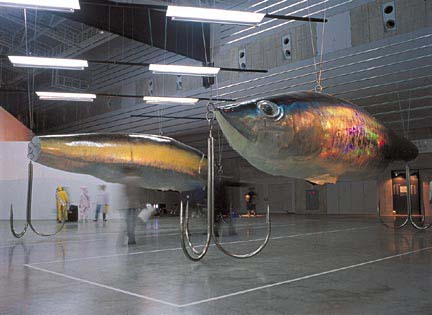Huang Yong Ping
dal 11/1/2002 al 9/1/2002
Segnalato da
11/1/2002
Huang Yong Ping
Barbara Gladstone Gallery, New York
"Om Mani Padme Hum" Born in 1954 in Xiamen, China, Huang founded the Xiamen Dada group in the mid-1980s and staged radical happenings that earned him the reputation as an avant-garde provocateur in his home country.

Barbara Gladstone Gallery is pleased to announce Om Mani Padme Hum,
an exhibition of works by Huang Yong Ping. Born in 1954 in Xiamen, China,
Huang founded the Xiamen Dada group in the mid-1980s and staged
radical happenings that earned him the reputation as an avant-garde
provocateur in his home country. Marcel Duchamp, John Cage and Joseph
Beuys were important influences, but Huang attributes the subversive nature
of his early work to a long-held conviction that art brings about reform. As he
explains, "in the social politics of China, art is part of the ideology. Doubting
the nature of art and destroying art is to destroy the political system. If one
thinks of art as a metaphor for reality, then to change the attitude towards
art means planning to change the way of thinking."
Today Huang continues to subvert traditional modes of thinking and cultural
stereotypes through his site-specific installation works. Since 1989 he has
been living in Paris, where his expatriate status affords him a unique
vantage point of the Western hegemony in the global discourse of
contemporary art. In his works Huang creates tensions and proposes
alternatives to Eurocentric ideology through materials and metaphors that
are as alien to Western audiences as he is. Unorthodox materials such as
cooked rice and live scorpions challenge conventional aesthetic definitions
while imposing risks on the sanctity of the institutional ‘white box’ museum
or gallery space. Similarly, numerous references to ancient Chinese history,
philosophy and mythology are deliberately obscure and difficult to decode.
More than merely sly critiques of Eurocentrism, his works are what Evelyne
Jouanno describes as "specific, strategic mediations between his Chinese
heritage and the ambient language of Western contemporary art."
The central work in this exhibition consists of a monumentally-scaled replica
of a prayer wheel (zhuan jing), a mechanical device used by Tibetan
Buddhists composed of a revolving metal cylinder mounted on a wooden
rod. The cylinder contains a consecrated scroll bearing the mantra Om
Mani Padme Hum, the six-syllabled truth that dispels evil and brings about
peace. Each turn of the wheel by hand is considered equivalent to orally
reciting the mantra. Here, Huang has dismantled the prayer wheel into four
elements rod, wheel, cover and scrolls and scattered them throughout
different spaces within the gallery, therefore demanding the viewer’s
physical engagement in order to apprehend the object in its constituent
parts. The violence implied in the dismemberment of the object acquires
further meaning when one learns that the rod is shaped like a Chinese
weapon called a mao; the cover resembles the Chinese character, dun,
meaning shield; and that the compound term mao dun means
"contradiction." For Huang, "contradictions are the pulse of life... without
them there is no authenticity." It should also be noted that Om Mani Padme
Hum defies translation, as it embodies all the teachings of the Buddha,
including the entire truth about the nature of suffering and the many ways in
which to remove its causes. The very inexplicability of the mantra falls in line
with Huang’s philosophy of contradiction.
Another work entitled Chariot du cycle des 60 ans consists of a wooden
cart surmounted by a figure of a man in ancient Chinese dress with his arm
outstretched. The prototype for this work is the South-Pointing Chariot, one
of the most complex mechanisms in the ancient world which the Chinese
invented during the 3rd Century B.C. In the ancient version, the figure is
connected to two wheels by means of differential gearing which, with a
combination of gear ratios, wheel diameters and distance between the
wheels, result in the figure always pointing in the same direction: south. In
his reinterpretation of the South-Pointing Chariot, Huang suggests that an
ancient, non-linear approach to progress may be applicable to our
modern-day world. As Hou Hanru observes, "with decolonisation and the
rise of powerful non-Western economies... the old discourses of
renaissance humanism and scientific rationalism, along with established
notions of nationhood and identity, are no longer adequate... in this context,
Huang Yong Ping’s introduction of Chinese systems proves effective in
negotiating the spaces of this emancipation."
In the Project Room Huang has installed a model of an unrealized work that
he planned for the Chapelle St. Louis Salpétrière in Paris. He envisioned
placing a giant prayer wheel upright in the choir of the chapel where it would
be perpetually rotating by means of a hidden motor. Persian carpets would
be laid on the floor and visitors would be asked to remove their shoes
before entering the installation. As a symbolic convergence of Christianity,
Buddhism and Islam, the three principal monotheistic religions of the world,
this work is an eloquent expression of hope for reconciliation.
Huang Yong Ping’s solo exhibitions include: CCA Kitakyushu, Japan; De
Appel, Amsterdam; Fondation Cartier pour l’Art Contemporain, Paris;
Atelier d’Artistes de la ville de Marseille; and New Museum of
Contemporary Art, New York. In 1989 Huang participated in the seminal
exhibition "Magiciens de la Terre" at Centre Georges Pompidou, Paris.
The artist represented France at the 1999 Venice Biennale, and currently
lives and works in Paris.
BARBARA GLADSTONE GALLERY
515 West 24th Street, New York, NY 10011 Tel 212.206.9300 Fax 206.9301
For further information please contact Emily Wei



